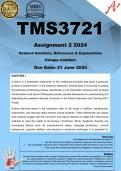Exam (elaborations)
TMS3721 Assignment 2 (COMPLETE ANSWERS) 2024 - 21 June 2024
- Course
- Institution
- Book
TMS3721 Assignment 2 (COMPLETE ANSWERS) 2024 - 21 June 2024; 100% TRUSTED workings, explanations and solutions. for assistance Whats-App 0.6.7..1.7.1..1.7.3.9 ........ Question 1 What do you think is the role of the theories in assisting the Life Orientation teacher in attending to the academic di...
[Show more]



